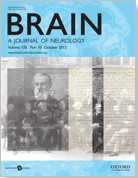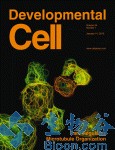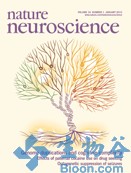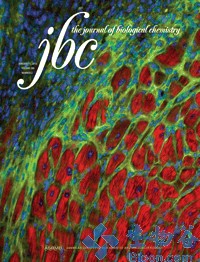Brain:开发出可改善中风患者失语症的新技术
2013-01-23 T.Shen Brain
近日,来自南卡罗来纳大学公共卫生学院的研究者通过研究开发出了一种“言语诱导”(speech entrainment)的新技术,这种新技术可以改善中风患者由于患布罗卡氏失语症所引发的言语缺失功能,使患者可以流利地进行讲话,相关研究刊登于国际杂志Brain上。 失语症是一种由于大脑左半球损伤而引发的严重的交流问题,主要表现为说话时断时续,通常在三分之一的中风患者中发生,严重影响个人的交流沟通能力。使
近日,来自南卡罗来纳大学公共卫生学院的研究者通过研究开发出了一种“言语诱导”(speech entrainment)的新技术,这种新技术可以改善中风患者由于患布罗卡氏失语症所引发的言语缺失功能,使患者可以流利地进行讲话,相关研究刊登于国际杂志Brain上。
失语症是一种由于大脑左半球损伤而引发的严重的交流问题,主要表现为说话时断时续,通常在三分之一的中风患者中发生,严重影响个人的交流沟通能力。使用这项新技术可以帮助患者明显改善其讲话的能力。
研究者Julius Fridriksson表示,我们这项研究首次实现了布罗卡氏失语症患者可以进行流利地语句交流,同时这项研究也帮助我们更深入地理解中风后患者的大脑功能表现,也为相应疗法的开发提供了帮助。
研究中,13个患者完成了3组单独的行为任务用于理解患者发声的转换和产生,每一位患者都完成了长达三周的训练,其每天都进行言语交流的训练。这项新技术可以帮助患者改善自主发音的产生能力,可以使得中风患者发出简短的脚本文字,并且可以轻松告诉别人。于此同时神经影像技术也帮助研究者更深入地理解了“言语诱导”发生的机制。
研究者Fridriksson说,前期研究揭示了言语诱导的训练可以改善布罗卡氏失语症患者言语产生的能力,这就为开发相应的治疗中风患者失语症的新型疗法提供了帮助和希望。

doi:10.1093/brain/aws301
PMC:
PMID:
Speech entrainment enables patients with Broca’s aphasia to produce fluent speech
Julius Fridriksson1, H. Isabel Hubbard1, Sarah Grace Hudspeth1, Audrey L. Holland2, Leonardo Bonilha3, Davida Fromm4 and Chris Rorden5
A distinguishing feature of Broca’s aphasia is non-fluent halting speech typically involving one to three words per utterance. Yet, despite such profound impairments, some patients can mimic audio-visual speech stimuli enabling them to produce fluent speech in real time. We call this effect ‘speech entrainment’ and reveal its neural mechanism as well as explore its usefulness as a treatment for speech production in Broca’s aphasia. In Experiment 1, 13 patients with Broca’s aphasia were tested in three conditions: (i) speech entrainment with audio-visual feedback where they attempted to mimic a speaker whose mouth was seen on an iPod screen; (ii) speech entrainment with audio-only feedback where patients mimicked heard speech; and (iii) spontaneous speech where patients spoke freely about assigned topics. The patients produced a greater variety of words using audio-visual feedback compared with audio-only feedback and spontaneous speech. No difference was found between audio-only feedback and spontaneous speech. In Experiment 2, 10 of the 13 patients included in Experiment 1 and 20 control subjects underwent functional magnetic resonance imaging to determine the neural mechanism that supports speech entrainment. Group results with patients and controls revealed greater bilateral cortical activation for speech produced during speech entrainment compared with spontaneous speech at the junction of the anterior insula and Brodmann area 47, in Brodmann area 37, and unilaterally in the left middle temporal gyrus and the dorsal portion of Broca’s area. Probabilistic white matter tracts constructed for these regions in the normal subjects revealed a structural network connected via the corpus callosum and ventral fibres through the extreme capsule. Unilateral areas were connected via the arcuate fasciculus. In Experiment 3, all patients included in Experiment 1 participated in a 6-week treatment phase using speech entrainment to improve speech production. Behavioural and functional magnetic resonance imaging data were collected before and after the treatment phase. Patients were able to produce a greater variety of words with and without speech entrainment at 1 and 6 weeks after training. Treatment-related decrease in cortical activation associated with speech entrainment was found in areas of the left posterior-inferior parietal lobe. We conclude that speech entrainment allows patients with Broca’s aphasia to double their speech output compared with spontaneous speech. Neuroimaging results suggest that speech entrainment allows patients to produce fluent speech by providing an external gating mechanism that yokes a ventral language network that encodes conceptual aspects of speech. Preliminary results suggest that training with speech entrainment improves speech production in Broca’s aphasia providing a potential therapeutic method for a disorder that has been shown to be particularly resistant to treatment.
本网站所有内容来源注明为“梅斯医学”或“MedSci原创”的文字、图片和音视频资料,版权均属于梅斯医学所有。非经授权,任何媒体、网站或个人不得转载,授权转载时须注明来源为“梅斯医学”。其它来源的文章系转载文章,或“梅斯号”自媒体发布的文章,仅系出于传递更多信息之目的,本站仅负责审核内容合规,其内容不代表本站立场,本站不负责内容的准确性和版权。如果存在侵权、或不希望被转载的媒体或个人可与我们联系,我们将立即进行删除处理。
在此留言












#失语症#
0
#失语#
77
#新技术#
58
#中风患者#
66